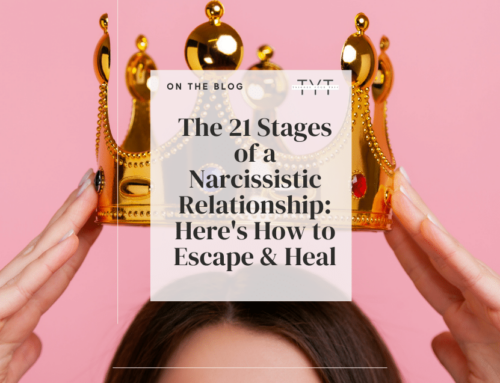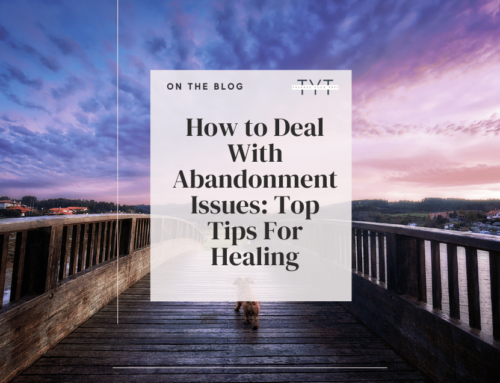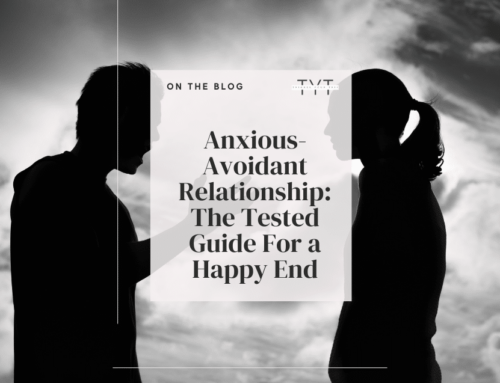Can you recall that friend who gets clingy and overly emotional when his partner forgets to call, but she’s also unresponsive to his efforts to form a close relationship? Or that guy with high avoidance of an intimate bond and a fear of ending up alone? These are typical behaviors of people with a fearful avoidant attachment.
What Is A Fearful Avoidant Attachment Style?
Individuals with a fearful-avoidant attachment style have a fear of both intimacy and rejection. They may want close relationships but feel uncomfortable with them simultaneously. Rarer than the other styles, a fearful avoidant attachment is the most detrimental yet rarer than the other three attachment styles, appearing in about 7% of the total population. An example of a person with a fearful avoidant attachment is the one who‘ll call you 50 times in one hour when you fall asleep in the bathtub but won’t respond to your efforts to make things official.
It’s essential for people who suffer from fearful attachment but also for those involved with them to speak with a mental health professional and better understand the roots of their attachment and the ways to heal.
Do you have difficulty choosing a mental health professional? Can’t afford in-person couples or individual therapy?
This online therapy toolbox is more efficient and affordable than any other virtual therapy I’ve tried, including BetterHelp and Talkspace. It instantly matches you with a therapist and saves you hours of research for the right one (with unlimited daily messaging and support from your therapist). By leveraging the power of CBT (Cognitive Behavioral Therapy) -the most common psychotherapeutic approach for treating mental health problems- your therapist will guide you to a happier self through weekly sections, CBT worksheets, unlimited messaging, and daily worksheet replies. Bonus points for the fact that you can do your sessions wherever you are in the world and message your therapist anytime, daily.
Let’s go into detail on the origins of these insecure attachment styles.
Attachment Theory & The Other Attachment Styles
Attachment theory is a psychological framework that explains how humans form and maintain emotional bonds with others, especially in parent-child relationships. It was first developed by John Bowlby in the 1950s and 60s.
According to attachment theory, early experiences with caregivers shape an individual’s beliefs and expectations about relationships throughout their lifespan. Specifically, attachment theory proposes that infants are biologically programmed to seek proximity to their caregivers when they experience distress or anxiety.
Through repeated interactions with a responsive and sensitive caregiver, infants learn to trust that their needs will be met and develop a secure attachment style.
However, suppose a caregiver is consistently unresponsive or unpredictable in responding to the infant’s distress. In that case, the infant may develop an insecure attachment style characterized by ambivalence or avoidance of close relationships.
These attachment styles can have long-lasting effects on an individual’s relationships and ability to regulate emotions.
The most widely studied attachment styles are the following:
Secure attachment style
Individuals with a secure adult attachment have had mostly responsive caregivers and feel comfortable with intimacy and independence.
Generally, they trust and rely on their partners and have a secure relationship base. Estimates vary, but research suggests that 50 to 60 percent of people have a secure attachment style and are happily bonded with their partners without the problems that the other insecure adult attachment styles would cause, such as jealousy, lack of trust, emotional withdrawal, passive aggressiveness, or fear of rejection.
Finding a secure romantic partner who can help you overcome your insecurities is vital for your emotional growth.
Anxious attachment style
Individuals with an anxious-preoccupied attachment style strongly desire intimacy and fear rejection yet often doubt their partners’ feelings while becoming overly dependent on relationships.
Can you recall that friend who needs constant validation, attention, and approval? Who assumes the worst if her partner doesn’t respond to her texts 24/7? Chances are, that friend is suffering from an anxious attachment style.
When combined with borderline personality disorder or emotional permanence, an anxious attachment style can harm your mental health and be the primary source of all your relationship problems.
Dismissive avoidant attachment style
Individuals with an avoidant attachment style fear closeness and rely on self-sufficiency, believing they can carry on all solo and don’t need anyone.
They unconsciously distance themselves from their partners and have difficulty forming close connections. Can you recall that ex of yours who, although they seemed to like you and enjoy your company, got cold feet whenever you expressed your feelings or lavished them with attention?
People with an avoidant attachment style have difficulty seeing an “I love you.” text on their screens. It’s one of the most terrifying things you can do to them.
Related: How to Let Go of Someone you Almost Had? (The Best Strategies)
Fearful avoidant attachment style (or disorganized attachment style)
A fearful avoidant attachment is also an insecure attachment style characterized by a fear of intimacy and a simultaneous need for it.
Fearful avoidant attachment develops in childhood and is usually triggered by past traumatic experiences such as abandonment or abuse, leading to feelings of vulnerability and mistrust towards others.
Individuals with this fearful attachment style have trouble in their emotional world, as they may avoid close relationships or suppress their feelings and desires to avoid rejection or abandonment.
Causes Of Fearful Avoidant Attachment
So how does a fearful avoidant attachment develop? People with fearful avoidant attachments tend to have some common experiences regarding their upbringing. Here are some common causes of fearful avoidant attachment:
Childhood trauma
Childhood trauma, such as abuse or neglect, can cause a fearful avoidant attachment style in several ways. Childhood trauma can lead to a fearful avoidant attachment style through a lack of secure attachment with a caregiver.
When a child experiences trauma, and their caregiver is not responsive or available to comfort them, they may believe that others are untrustworthy and that it is unsafe to rely on them for support.
As a result, the child may fear intimacy and become hesitant to form close relationships later in life.
Related: The 7 Stages of Trauma Bonding; Here’s Why You Can’t Leave
Scary parental behavior
Threatening parental behavior can cause a fearful attachment style, undermining a child’s sense of safety and security in their relationship with their caregiver.
When a child experiences dangerous or unpredictable parental behavior, such as yelling, physical punishment, or emotional abuse, they may feel frightened and uncertain about how their caregiver will respond to their needs or emotions.
This can lead the child to develop a sense of anxiety and distrust towards their caregiver and, thus, their adult relationships.
Punitive parents
Punitive parenting refers to using harsh, critical, or punitive discipline methods, such as physical punishment, verbal aggression, or emotional abuse, to control or correct a child’s behavior.
When children experience punitive parenting, they may become afraid of their parents and learn to associate emotional intimacy and vulnerability with punishment or rejection.
As a result, they may fear being emotionally open or reliant on others, leading to avoiding close relationships and emotional intimacy. This can lead to a sense of emotional detachment and a lack of confidence in the reliability of others, which can further reinforce a fearful avoidant attachment style.
Inconsistent attachment figures
Inconsistent attachment figures may cause the child to experience conflicting emotions toward their caregivers, which can further contribute to developing a fearful avoidant attachment style. That’s a common scenario when children change foster homes at an early age.
The child may desire emotional closeness and security from one caregiver who then, for various reasons, goes away, which the child perceives as abandonment and rejection. That leads to ambivalence towards who their attachment figure is and how they can develop a trustworthy emotional bond.
Depressed or alcoholic parents
Finally, children of depressed or alcoholic parents may experience a lack of stability and predictability in their home environment, which can interfere with developing a secure attachment style.
The parent’s depressive symptoms or alcohol use may lead to unpredictable and chaotic behavior, creating a sense of fear and insecurity in the child.
This can lead to avoiding close relationships and emotional intimacy, as the child may perceive emotional closeness as a potential source of danger or threat.
Signs Of Fearful Avoidant Attachment
Extremely low self-esteem
Overall, extremely low self-esteem can manifest the underlying fear and insecurity associated with a fearful attachment style. Individuals with a disorganized attachment style may struggle to regulate their emotions, leading to anxiety, depression, and low self-esteem.
They may also have difficulty expressing their needs and emotions, leading to powerlessness and a lack of control in their relationships.
A fearful-avoidant person also tends to have negative beliefs about themselves and their relationships with others.
High anxiety when forming close relationships
Individuals with fearful avoidant attachment styles tend to have high anxiety when forming close relationships because they have conflicting desires for intimacy and independence. This inner conflict between the desire for intimacy and the fear of vulnerability and abandonment can lead to high anxiety levels when trying to get close to others.
In addition, people with fearful avoidant attachments may have difficulty regulating their emotions, which can exacerbate anxiety and fear.
Related: The 10 Best Crystals for Self Love to Manifest Confidence
Simultaneous fear of rejection and closeness
Fearful avoidant people fear both rejection and closeness.
The parents’ unresponsiveness can cause an individual to develop hyper-independence and a strong desire for self-reliance as a coping mechanism. This can lead to a fear of vulnerability and a tendency to avoid emotional intimacy, as it may be perceived as a threat to their emotional well-being.
At the same time, they are also scared of rejection, as it might trigger their past trauma, making them feel vulnerable and anxious about not having the proximity they need.
Trouble forming personal relationships
Individuals with fearful avoidant attachments can have trouble forming personal and intimate bonds because they may have learned that relationships are unpredictable, unsafe, or frightening.
In addition, individuals with disorganized attachment may have difficulty regulating their emotions, which can lead to unpredictable behavior and instability in their romantic relationships.
Plenty of negative views and emotions
Fearful avoidants have a negative view and limiting beliefs about themselves and their relationships with others, which can lead to low confidence and feelings of inadequacy.
Their negative emotions stem from not having a reliable caregiver to provide them with a safe and secure base, making them feel worthy.
As a result, they may struggle to trust others, believe that they truly care for them, and thus form a healthy adult attachment.
Difficulty asking for help or support
A person with fearful attachment struggles to ask for help because they may have learned as a young child that seeking help or support from others can lead to rejection or harm, a thought usually manifested by the caregiver’s behavior.
As a result, individuals with insecure styles may have learned to cope with their needs and emotions independently rather than seeking help or support from others.
They may also struggle with trusting others and fear rejection or abandonment if they ask for help, yet, they crave closeness.
Read more: How Hyper-Independence Can Signify Trauma (& 5 Ways To Cope)
High dislike of becoming caregivers
One reason why fearful avoidant individuals may not want to become parents is that they may fear repeating their own insecurities and the same patterns of insecure attachment with their children.
They may worry that they will not be able to provide the emotional support and security that their children need or that they will unintentionally cause harm to their children.
Fearful avoidant individuals may also struggle with intimacy and emotional closeness, which are important components of parent-child relationships. They may feel uncomfortable with the level of vulnerability and emotional expression required in parenting and may find it challenging to meet their child’s emotional needs.
Related: 9 Mommy Issues in Men That Make Him Avoid Commitment
4 Tips on Coping With Fearful Avoidant Attachment Style
By now, you might have self-diagnosed with a fearful avoidant attachment style as you might possess characteristics from it.
The good news is that insecure attachment styles are flexible and can change over time with positive and healthy relationships, experiences, self-reflection, emotional healing, or therapy.
I’m here to help you understand what triggers it, show you how you get in touch with your feelings and underlying behaviors, suggest available resources on overcoming it, and set you up for success.
Learn all you can about it
If you suspect you’re suffering from disorganized attachment, the key lies in learning about developing a more secure style.
An organized strategy for developing self-awareness and learning how fearful avoidant attachment makes you repeat the same relationship patterns is essential to feel confident.
You can start educating yourself through books, articles, and research studies about adult attachment. Learn about its characteristics, causes, and effects, practice self-reflection, and consider what factors in your early childhood triggered your symptoms.
Read more: The 150 Top Shadow Work Prompts to Unblock Your Potential
Spot behavior troubling behavior patterns
By reflecting on your experiences and relationships, you can identify specific behaviors, dissociative symptoms, or thought patterns that might contribute to your attachment style. Fearful avoidants can have devastating relationships when paired with romantic partners with insecure adult attachment styles.
Work to build healthy relationships with others and consider finding secure partners who can respect and understand the type of relationship you’re trying to build.
Related: Trapped in a Narcissistic Relationship Pattern? The 7 Awful Signs
Understand your emotional needs and set boundaries
Take care of your emotional and physical well-being by engaging in activities that promote relaxation, stress relief, and a positive self-image.
Understand that your need to increase closeness and take your space is not good or bad; it’s simply your need, and you want somebody to make you feel secure and respect it.
This may involve setting healthy boundaries, practicing effective communication, and being open to vulnerability and emotional expression.
Seek therapy
Consider working with a therapist who has experience in attachment theory and can help you understand and work through your attachment style.
Therapists may use a variety of approaches, such as cognitive-behavioral therapy, attachment-based therapy, or emotion-focused therapy, to help you develop more secure attachment patterns.
Related: The 43 Best Spiritual Healing Quotes for Instant Self Therapy
Final thoughts
In conclusion, the article highlights the challenges of individuals with fearful avoidant attachment, who desire love and connection but simultaneously fear the vulnerability and potential rejection that come with it.
The seven signs in the article and the causes and tips on overcoming them provide useful insights for individuals struggling with this attachment style or trying to understand someone who does.
Ultimately, recognizing and acknowledging one’s attachment style is the first step towards building healthier relationships and improving emotional well-being.
With self-awareness, compassionate communication, and professional support, overcoming the challenges of fearful avoidant attachment and experiencing deeper, more fulfilling connections with others is possible.





